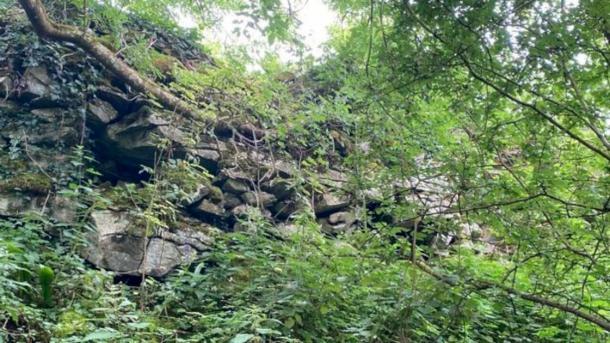
Huge New Bronze Age Fortress Discovered in Irish Nature Preserve!
While carrying out routine field work in the Burren lowlands of County Galway in Ireland, field archaeologist Michael Gibbons discovered a Bronze Age fortress that may be almost 3,200 years old. The expansive ancient rock fortress is approximately 1,300 feet (400 meters) long on its north and south sides, and measures about 328 feet (100 meters) along its eastern and western walls. The latest Irish Bronze Age fortress is bounded on all sides by turloughs, a type of seasonal lake found only in Ireland west of the River Shannon. The turloughs were completely dry part of the time and filled with water at other times. When filled with water they could form a barrier that was virtually impenetrable.
It is clear the location of the Irish Bronze Age fortress was carefully chosen by its architects, who wanted to make the structure as difficult as possible for enemies to reach.
When he made this fascinating discovery, Gibbons was working on an assignment for the Muintearas project. This is an educational initiative that is dedicated to protecting and preserving the language, society, and traditional culture of Ireland’s Irish-speaking areas.

The remains of the almost forest covered Irish Bronze Age fortress recently discovered by field archaeologist Michael Gibbons in Galway County, Ireland. (RTE News)
Hidden in Plain Site: A Gigantic Bronze Age Fortress!
The gigantic structure Michael Gibbons analyzed and ultimately identified had actually been known about for quite some time. The fortress can be found inside the boundaries of Coole Park, a 1,000-acre (four-square-kilometer) nature preserve located a short distance from the County Galway town of Gort.
The latest Irish Bronze Age fortress was easy to identify as a structure of some type, but its antiquity had been unknown and it had therefore not attracted that much interest among archaeologists and historians.
But Gibbons was intrigued enough to carry out a more extensive examination of the stone structure, and the results of his survey suggested it had been built sometime between 1200 and 800 BC.
- The Bronze Age - A Spark That Changed the World
- 1,000-year-old underground passage discovered in the Caha Mountains of Ireland
Gibbons told RTE News that the large rock enclosure was comparable in size to the famed Dún Aonghasa fortress on Inis Mhór in the Aran Islands, which mark the entrance to Galway Bay in the North Atlantic. He said the fortress would have been large enough to house and protect up to 200 people.
There is a “magical, otherworld quality about the whole landscape,” Gibbons stated.
Much of the land surrounding the newly identified Bronze Age fortress is covered with dense forest, and the forest has grown quite tall inside the walls of the structure. However, Gibbons and his colleagues plan to continue exploring the fortress’s interior spaces intensively in the next few months, searching in particular for the crumbling ruins of Bronze Age roundhouses.
To supplement their on-the-ground analysis, the researchers have so far taken several aerial surveys of the structure and the surrounding area with LiDAR technology. This innovative exploration tool uses reflected laser light to construct three-dimensional recreations of sections of the earth photographed from above.
“We know that there were numerous roundhouses within it, that they’re metalworking, and that they’re making high status artifacts,” Gibbons told the online publication ARTnews. The archaeologist is currently waiting for the accumulated LiDAR data to be fully analyzed, and he and his fellow researchers hope it provides evidence that multiple roundhouses were constructed inside the fortress’s ramparts.
Roundhouses were the preferred form of dwelling for most people who lived in the lands of the United Kingdom during the Bronze Age (2500 to 500 BC) and for some time beyond. These solid, low-built structures included walls that were made from wooden or stone posts installed in pre-dug post holes. Bronze Age builders filled the spaces in between the inner and outer sections of the walls with a mixture of earth, clay, and twigs, to insulate the living area against cold and moisture. Roundhouses were covered with thatched roofs that allowed smoke from cooking or heating fires to easily escape.
Roundhouses weren’t always built inside fortress walls. It seems the people who lived in the Bronze Age fortress constructed in Coole Park were fearful of outside invaders, and they likely felt they had no choice but to shut themselves off behind the rocky walls of a large defensive enclosure.

The stone outline of the huge Irish Bronze Age fortress constructed in Coole Park is clearly visible between the turlough lakes. (RTE News)
A Magical Landscape Waiting to Be Discovered
The CEO of Muintearas, Seán Ó Coistealbha, expressed his delight at Gibbons’ unique discovery.
- Ireland as Atlantis – Ancient Egyptian and Greek Clues
- Experiment Reveals Secrets to Brutal Bronze Age Warfare
"The amount of work that went into this incredible fortress by men and women in ancient times is incredible," Ó Coistealbha said to RTE. "There is a wealth to be discovered yet. We are just skirting around the stone boundaries of a hidden civilization, or a hidden population, or a hidden era in the past of Ireland."
Explorations in the area around the fortress will likely pick up as archaeologists now know that a Bronze Age fortress and settlement existed at the site between 2,800 and 3,200 years ago. For now, they can only guess how far beyond the fortress’s walls Bronze Age residents ventured, but it is likely that many other ruins and artifacts will eventually be excavated or identified in this small part of County Galway’s magical landscape.
Top image: Field archaeologist Michael Gibbons, left, discovered the outlines of this gigantic Bronze Age fortress, partially visible in the background of this image, which may be nearly 3,200 years old, while carrying out routine field work in a nature preserve in County Galway, Ireland. Source: YouTube screenshot / RTE News
By Nathan Falde















